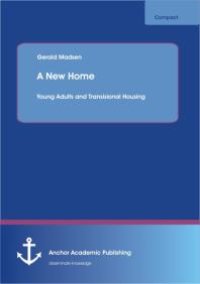
Ebook: A New Home: Young Adults and Transisional Housing : Young Adults and Transisional Housing
Author: Gerald Madsen
- Tags: Public housing -- Europe., Homeless families -- Europe., Social work with the homeless -- Europe.
- Year: 2014
- Publisher: Diplomica Verlag
- City: Hamburg, GERMANY
- Edition: 1
- Language: English
- pdf
Homeless young adults represent a failure of the U.S. social services system to prevent new generations of homeless people. However, several organizations are working in concert with communities and governments to combat this problem through transitional housing programs that target young adults ages 18 to 24. Many of these programs mirror the new urban development trend of mixed-income housing, and place transitional houses inside stable neighborhoods that are either affluent or mixed-income themselves. While these programs represent monumental commitments in terms of resources, they also represent hope for many young adults. The sense of community these young-adult residents feel toward their neighborhoods and programs have lasting effects on the residents’ abilities to find normalcy inside the American culture through access to education, safety, and employment. This study examines the YMCA Young Adult Services Program (serving the greater Seattle area) for transitional housing, exploring how the program works and what is residents’ psychological sense of community. Auszug aus dem Text Text Sample: Chapter, ZIP Codes, Census Tracts & Housing Location: There are six shared homes and an apartment-based program (YAIT) in the YMCA-YAS program. Together, they represent housing for 48 young adults, 19 of which are studios in YAIT. With the exception of YAIT—which is located in the business district of downtown Seattle inside the YMCA—the houses are located in affluent neighborhoods (A. Fox, personal communication, January 23, 2013). Placement of the housing is important, influencing a sense of community held by residents. Therefore, income statuses for two of the houses—the West Seattle and Central Seattle houses—are examined using 2010 U.S. Census data. Tract data were drawn from the 2010 Census Interactive Population Search (n.d.) and the U.S. Census map King County (033) (King County (033) (205053033001), 2010). U.S. Census data at the ZIP Code level provided an overall view of the larger neighborhood. West Seattle house, U.S. Census Tract no. 109, ZIP Code 98106: Tract no. 109 has a population of 1287, of which 496 (39%) live in owner-occupied dwellings and 55% live in rented housing. One-thousand one-hundred twenty-four residents reported being 18 years or older, and the majority (703) were aged 25 to 49. Seventy percent self-reported as White4 and 10% self-reported as Asian. African-American, American Indian and Alaskan Native, Native Hawaiian and Pacific Islander, and Other made up the remaining 20% (2010 Census Interactive Population Search, n.d.). ZIP Code 98106 has a population of 22,873. The largest age group falls into the 25 to 49 range, comprising 35% of the population or 20% fewer than the 55% that comprised the same population in Tract no. 109 (American factfinder – results, n.d.a). The three largest sectors of employment for 98106 are (a) professional, scientific, management, administrative, and waste management services at 16.6%, (b) education services, healthcare, and social assistance at 18.2%, and (c) arts, entertainment, recreation, accommodation, and food services at 12%. Income for 98106 is concentrated in the $50,000 to $74,999 and $75,000 to $ 99,999 ranges, with 24.1% and 13.9%, respectively. The remainder of the population is concentrated below the $50,000 level, and 7.2% of the population reported earning fewer than $10,000 per annum (American factfinder – results, n.d.b). Education showed a spread that coincided with the employment sectors. For the 98106 ZIP Code, 26% of the population reported having some college, 21.9% reported a four-year degree, and 18% completed high school (excluding GEDs) (American factfinder – results, n.d.c). These data suggest a mixed-income and mixed-education population at the ZIP Code level. Central house, U.S. Census Tract no. 76, ZIP Code 98112: Tract no. 76 has a population of 3498, of which 1342 (39%) live in owner-occupied dwellings and 59% live in rented housing. Three-thousand eighty-six reported being 18 years or older, and the majority (2039) were aged 25 to 49. Seventy-six percent self-reported as White4 and 11% self-reported as African American. Asian, American Indian and Alaskan Native, Native Hawaiian and Pacific Islander, and Other made up the remaining 13% (2010 Census Interactive Population Search, n.d.). ZIP Code 98112 has a population of 21,077. The largest age groups fall into the 25 to 49 range, comprising 43% of the population or 15% fewer than the 58% that comprise the same population in Tract no. 76 (American factfinder – results, n.d.d). The two largest sectors of employment for 98112 are (a) professional, scientific, management, administrative, and waste management services at 24% and (b) education services, healthcare, and social assistance at 26.3%. Unlike 98106, no third sector employed more that 10% of the population. Income for 98112 showed a similar deviation from ZIP Code 98106. Income was concentrated at the $50,000 to $74,999, $100,000 to 149,999, and $200,000 and greater brackets, with 15%, 17%, and 17%, respectively (American factfinder – results, n.d.e). Education showed a spread that coincided with the employment sectors. For the 98106 ZIP Code, 37% of the population reported having a four year degree and 38% a graduate or professional degree. Only 12% reported having some college, but no degree, and 5.5% had a high school education (excluding GEDs) (American factfinder – results, n.d.f). Unlike the West Seattle house, the Central house is located in a dual-income environment that favors the upper income brackets. This is also reflected in the levels of education, where 38% reported a post-graduate education. Unlike the West Seattle house, the Central house is not situation in a mixed-income neighborhood, but it is located in an upper-class area. Story of Sue3: Sue’s story is both sad and triumphant. Sad because her situation is common among Americans, but triumphant because she moved beyond her initial environment and grew as a person and member of her community. Sue was an only child, and did not meet her biological father until she was in her late teens. In Sue’s early years, she suffered poverty, kidnapping by a mentally ill friend of her mother, and a life where she and her mother were never far from homelessness. Later, her mother met and married her stepfather, the man she has since referred to as dad. As Sue grew up, her parents had two more children and moved many times following work and the hope of a stable life. Sue, quickly became a second mother to her siblings, further linking her to the family as a needed resource. Living in poverty, with working poor parents and two dependent siblings, Sue felt trapped. Eventually she escaped to Cascades Job Corps Center with a young man, her fiancé. The environment and isolation was no different for Sue, and the man she thought she would marry turned abusive; once again Sue was moving. Having completed her GED at Job Corps but not her job training, Sue was left unemployed and living between her parents’ apartment and the family of her new boyfriend. Sue felt something no middle-class American may truly understand: the knowledge that she must escape, but lacking the social and economic resources to do so. When Sue’s father found work in a pie factory in Spokane, she readied herself for another move. Spokane was a different environment for Sue. Her family moved from the urban slums of Everett to a suburban neighborhood in southeast Spokane. Her father obtained stable work at a pie factory, and her siblings had a yard for the first time. For a short time, Sue held a job while exploring the tribulations of being a first-generation college student. Her family life, however, was unstable. She quickly fell into the role of homemaker and parent to her siblings while her father worked the third shift. Her parents fought and talked of divorce, and her father drank. She lost her job due to a misbalanced till, missed a quarter of school, and began to fall into the old habits of despair. Most of Sue’s social capital was negative; her friends, family, and environment centered on a culture of poverty. Her father lost his job, her parents were fighting, and her mother was seeing another man. Their housing relied on her brother’s disability check and the good graces of their landlord.
Download the book A New Home: Young Adults and Transisional Housing : Young Adults and Transisional Housing for free or read online
Continue reading on any device:

Last viewed books
Related books
{related-news}
Comments (0)








